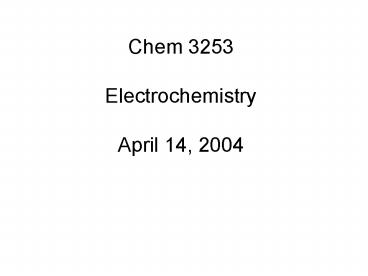Chem 3253 Electrochemistry April 14, 2004
1 / 17
Title:
Chem 3253 Electrochemistry April 14, 2004
Description:
The Ilkovic equation: id = 607nD1/2m2/3t1/6C. What is generally done is to keep ... in a 50.0 mL sample of orange juice is determined by voltammetry using the ... –
Number of Views:129
Avg rating:3.0/5.0
Title: Chem 3253 Electrochemistry April 14, 2004
1
Chem 3253ElectrochemistryApril 14, 2004
2
Four Electroanalytical Methods
- 1) Potentiometric
- 2) Voltammetric, Polarographic, Amperometric
- 3) Electrolysis (including electrogravimetric
and coulometric) - 4) Conductiometric
- We will consider the details of each of these
- separately.
3
Polarography
- The Ilkovic equation id 607nD1/2m2/3t1/6C
- What is generally done is to keep all of the
- Variables constant and plot id vs. Conc.
- Alternately, the Standard Addition Method
- may also be used this is shown later for
- voltammetry.
4
Polarography
- Advantages
- Both qualitative (value of E1/2) and
quantitative (id ) data obtained. - Quantitative data to 10-5 M
- Applications to kinetic data such as the rate of
electron transfer
5
Polarography
- Disadvantages
- Samples must have O2 removed.
- Oxidation/reduction must occur in the potential
window provided by the DME, - -1.3 to 0.1 volts vs. SCE
6
Other forms of polarography
- In classical polarography the applied voltage is
a linear ramp imposed - on the working electrode as shown in a).
Modifications have been a - Time stair step ramp as shown in b), or an small
AC signal on the ramp.
7
Voltammetry
- The data is very similar to polarography, the
measurement of current vs. voltage at the working
electrode. The equipment is shown in the
following slide. Other electrodes are used,
including graphite pictured in the next slide,
and Pt or Au. The various electrodes allow for
more anodic potentials as shown in the left
margin on page 356. The voltammetrograms
obtained are similar to polarogragrams, without
the oscillations caused by the breaking mercury
drop.
8
Voltammery
9
Voltammery
10
Data for Oxidation of Ascorbic Acid
11
Data for Oxidation of Ascorbic Acid
Ascorbic Acid in a 50.0 mL sample of orange juice
is determined by voltammetry using the standard
addition method.
12
Data for Oxidation of Ascorbic Acid
Standard addition plot of data for the oxidation
of Ascorbic Acid.
13
Cyclic Voltammetry
- Cyclic Voltammetry - applies a cathodic dc ramp
voltage to - the working electrode (generally a hanging drop
mercury - (HDME) or a spinning Pt electrode), then reverses
the - ramp and sweep back in anodic direction to the
starting - potential. A cyclic voltammetrogram is shown in
the next - slide.
14
Cyclic Voltammetry
15
Cyclic Voltammetry
- Advantages
- rapid analysis - can vary the sweep rate
- useful in study of the reversibility of the redox
process. - study the kinetics of redox process
16
Stripping Analysis
- Stripping Analysis - consists of 2 steps
- pre-electrolysis, where the analyte is
concentrated by electrolysis on the working
electrode. - 2) reverse electrolysis or stripping the amount
of material deposited is obtained from the
integral of the current-time curve, essentially
coulometry - sensitivity to 10-9 M separate peaks for each
component.
17
Stripping Analysis































